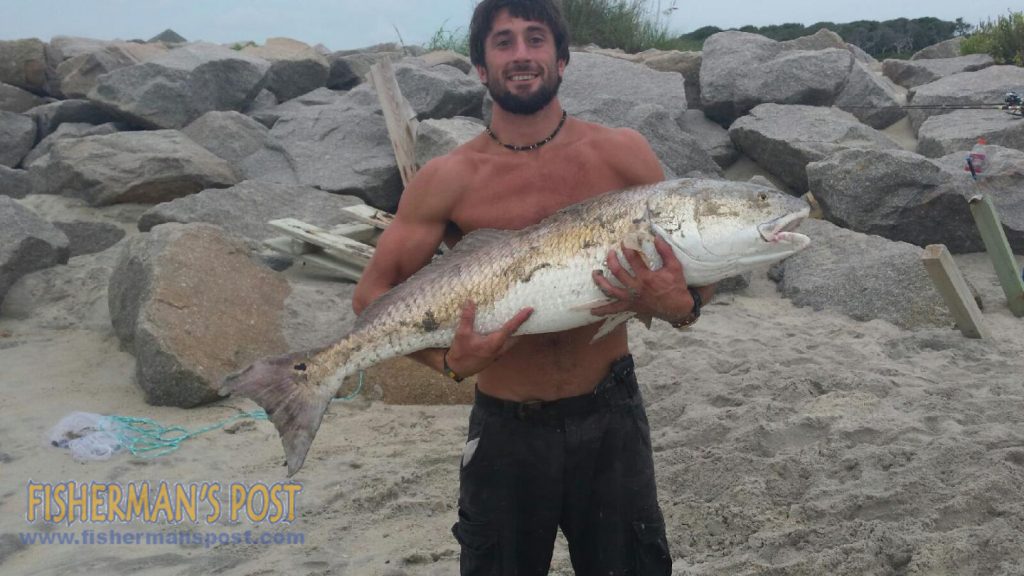Carolina Beach – October 8, 2015
Ron, of Island Tackle and Hardware, reports that anglers are just beginning to get back on the water after more than 10 days of wind and rain. It will likely take the area’s inshore fishing a few days to get back on track after the weather, but anglers are already seeing some encouraging signs.
Some speckled trout and flounder have been biting in the Cape Fear River near Snows Cut since the storm. Live shrimp were fooling both, and the best action seems to be on high, falling tides. Anglers thinking about fishing the river should be very cautious in navigation, however, as logs and other debris are prevalent after the rain and high water the area saw over the weekend.
Before the storm, speckled trout and red drum were feeding from well north of Snows Cut down to Bald Head Island, so the action should be good once the water has a chance to clean up.
Flounder fishing had been decent in Carolina Beach Inlet and along the ICW prior to the storm, with most of the flatfish falling for live baits like mud minnows, finger mullet, and shrimp.

Ashley Marie, of Currie, NC, with a red drum that inhaled a white Gulp shrimp in the lower Cape Fear River while she was fishing with her boyfriend Nick King.
Surf casters also saw some good fishing last week, landing sea mullet, pompano, spot, flounder, bluefish, and red drum. Shrimp, cut baits, and finger mullet have been fooling most of the fish in the surf.
Anglers also connected with some large red drum from the beach and piers as the surf grew last week. Big chunks of cut mullet and spot are fooling most of the reds.
Not many anglers had been offshore last week, but spanish and king mackerel should become available targets within 10 miles of the beaches as the water settles down. Anglers can tempt the spaniards to bite Clarkspoons and other trolling lures and hook the kings while slow-trolling live and dead baits.
Those making the run to the Gulf Stream should be able to connect with some wahoo and blackfin tuna, as October is typically an excellent month for both fish. Ballyhoo paired with skirted trolling lures are the best bets for both predators.

Justin Whitley, of Wilmington, with a 90 lb. tarpon that bit a live mullet on the bottom in the ocean near Carolina Beach while he was fishing with Capt. Christian Wolfe of Seahawk Inshore Fishing Charters.
Robert, of Carolina Explorer Charters, reports that anglers are seeing good numbers of spot showing up on Carolina Beach’s piers, and they’re hooking them on natural and artificial bloodworms.
Prior to last weekend’s storm, there was some decent flounder action in the ICW near Carolina Beach, so the flatfish should be back on the feed when the inshore water cleans up a bit. Live baits like finger mullet are the way to go for the flounder.
The northeast winds last week pushed some local anglers to target nearshore structure off Oak Island, where they found large (some to 40”+) red drum along with good numbers of gray trout. Both fish will bite live or cut baits fished on the bottom. There’s likely much of the same at nearshore rocks and wrecks on this side of Cape Fear, but anglers haven’t been able to get out and find out for a few days.

Chris Natale with a 43″ red drum that attacked a pinfish head while he was shark fishing at Fort Fisher.
Jeff, of Seahawk Inshore Fishing Charters, reports that anglers can find large “bull” red drum feeding at nearshore structure off Carolina Beach when the weather’s calm enough to get in the ocean. Large chunks of mullet, spot, and menhaden are top choices for the big reds.
Smaller red drum are feeding in the creeks and on the flats off the lower Cape Fear River. Anglers can hook the smaller fish on topwater plugs, Gulps and other soft baits, or live mullet and shrimp.
Flounder should be feeding inshore until well into November. Anglers can find them in the same places as the reds and hook them on Gulps or live baits.
Anglers should also see the speckled trout bite heat up as the water cools off over fall. The specks will feed around grass islands, oyster points, and other current breaks, and anglers can hook them on live shrimp and mullet or a variety of artificial lures.

Parker Smith with an upper-slot red drum that engulfed a live mullet while he was fishing with his father in Carolina Beach Inlet.
Brenda, of Carolina Beach Pier, reports that bottom fishermen have been hooking some spot and sea mullet on shrimp and bloodworms.
Some large red drum are biting big cut baits fished on the bottom.

James Brooks, of Siler City, NC, with a 21″ flounder that bit a soft plastic bait near a Cape Fear River dock.
Anthony, of Kure Beach Pier, reports that spot, croaker, and small black drum are biting shrimp and bloodworms on bottom rigs.
Anglers have also been landing some speckled trout from the pier on cut baits.
Red drum (most over-slot but a few keepers) are biting off the pier as well, and cut baits and finger mullet have been getting their attention.
